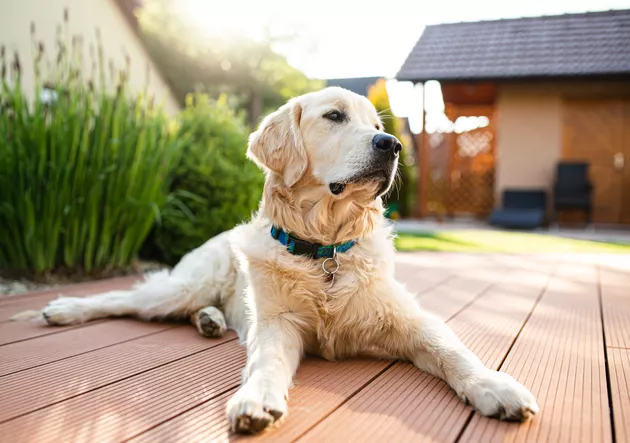By Sassafras Lowrey
7/17/2023
cuteness.com
Summer is here, & most areas of the county will be hot for several months. The hot weather can be fun, but it's also dangerous. While exercise & enrichment are important for dogs year-round, it's important to be cautious when taking your dog out during the hot weather. Here are 7 safety tips to keep in mind when walking or exercising your dog this summer.
1. Watch out for hot pavement temperatures
One of the main concerns with walking dogs in the summer is the pavement temperatures. Concrete sidewalks & streets heat up in the sun & can easily burn your dog's paw pads. The general approach for determining if the concrete is too hot is to put the back of your hand onto the surface for 7 seconds. If you can do so comfortably, then it may be cool enough for your dog to walk comfortably.
To protect your dog from both the heat & hot concrete, it's best to avoid walking during the hottest time of the day. Instead, try to arrange your schedule to get your dog out on walks during the early morning or late at night — when the concrete will be cooler. If you live in an apartment & must walk your dog on hot concrete to get them out to potty, consider investing in protective boots. Use positive reinforcement methods to teach your dog to be comfortable wearing them.
2. Know the signs of heat stroke in dogs
One significant risk in the hot weather for dogs is the risk of heat stroke. All dogs can overheat, including active & young dogs.
The best way to prevent heat stroke is to keep your dog in a cool part of your house during the hottest part of the day. When you are outside with your dog, provide them with access to cool places in the shade. It's also best to avoid encouraging strenuous play or exercise for your dog in the heat. Avoid those long walks and games of fetch during the hottest parts of the day.
Symptoms of heat stroke to watch out for include:
-Panting
-Heavy breathing
-Pale gums
-Lethargy
-Gastrointestinal issues including vomiting
If you think your dog is experiencing heat stroke, take them to the veterinarian immediately.
3. Bring cooling clothing & accessories
In addition to sticking to shady areas & walking in the early morning or late at night, providing your dog with cooling accessories can also be helpful. Cooling coats & cooling bandanas can help keep your dog comfortable & prevent overheating while out on a walk. Cooling vests are designed to be soaked in cool water. Hold the cooling vest against your dog's body to help deflect the sun & keep them feeling cooler.
4. Avoid discarded food on sidewalks
Summer BBQ gatherings are fun, but they can lead to dangers when walking your dog. Chicken bones, partially eaten bags of chips & other BBQ leftovers are especially common on sidewalks this time of year. This discarded food could make your dog sick if they eat them. When walking your dog, keep an eye out for tempting distractions & steer your dog away from them. This is a great time to practice cues like "leave it" & "drop" if your dog does manage to get something in their mouth that they shouldn't.
5. Stay hydrated
Keeping you & your dog well hydrated is important when out on summer walks. Carry a water bottle for yourself & fresh cool water to share with your dog. You'll also want to bring a portable or collapsible water bowl to make it easier for your dog to drink. Avoid letting your dog drink out of communal neighborhood water bowls, as they can spread disease.
Foxtails are a weed that looks harmless, but is very dangerous to dogs. Common in the western United States, these wheat-looking seeds have barbed heads. Foxtails can easily become embedded in your dog's feet, nose, ears, & eyes & lead to serious infections. Foxtails don't naturally break down & instead work their way into a dog's body. This can lead to serious infections or even death if untreated. Keep your dog out of weeds & tall grass & inspect your dog's body after each walk.
7. Watch for insects & snakes
Insect stings or snake bites (depending on where you live) can be another hazard to watch for on summer dog walks. Keep your dog away from snakes & other wildlife. It's helpful to have easy access to a first aid kit for dogs & to know how to use it. If you suspect your dog has been stung by an insect, & they are having any kind of reaction such as obvious discomfort, swelling, or difficulty breathing — then your dog should immediately be seen by a veterinarian.
The bottom line
Taking your dog out for summer walks can be a lot of fun, but there can also be unexpected dangers. Be thoughtful about what time of day you take your dog out to walk. Avoid the hottest part of the day & check the temperature of the pavement before walking. Try to keep your dog cool while walking & carry fresh water. Steer your dog away from any tempting food left on sidewalks. Avoid tall grass & assorted wildlife hazards.
Cute Critter Pics:
Weekly Chuckle:










.jpg)



No comments:
Post a Comment